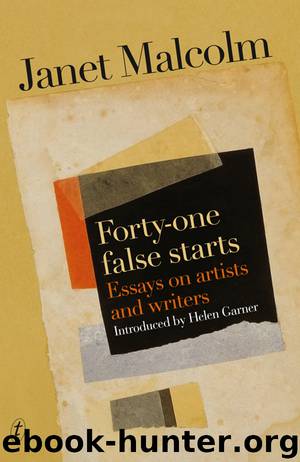Forty-One False Starts by Janet Malcolm

Author:Janet Malcolm
Language: eng
Format: epub
Tags: Non-Fiction, Essays
ISBN: 9781922148230
Publisher: The Text Publishing Company
Published: 2013-04-23T16:00:00+00:00
In 1984 a book with the quiet title Julia Margaret Cameron, 1815–1879 was published in England, and it almost crackled with the indignation of its author, an Oxford professor named Mike Weaver, who couldn’t bear the way Cameron and her work had been, as he saw it, condescended to and misjudged by Woolf, Fry, et al. Here is Weaver’s testy commentary on the legend of the wacky great-aunt:
The story that her children gave her a camera to pacify her while [Charles Cameron] was away . . . is another of those many anecdotes which aim to rob her of her dignity as woman and artist, and have taken the place of criticism of her work . . . The anecdotes attempt to turn her into a blue-stocking. She is depicted as obsessed with old-fashioned shawls, with fingers stained with chemicals (what do women know about science?) . . . Some have suggested it was all too much for poor Charles and other alleged “victims,” but there is no sign of conflict between them, rather a sense of deep and lasting relationship based on mutual admiration. She was the Mrs. Gaskell of photography. She seems to have accepted maternity and marriage as high and holy offices, and lived an active life in which art relieved her from daily household cares. She was not an invalid, not repressed, and not inadequate. She was a nice-looking woman, who was a fine person. Her sisters, all younger than her, for all their famed beauty, could not hold a candle to her. A Christian artist, she submitted her passions and her pride to the will of others, and, above all, to God. If it were not so unfashionable, I would have called her a genius . . .
Far from dismissing the fancy-subject pictures as kitsch, Weaver holds them up as the essential core of Cameron’s oeuvre, the culminating expression of the Christian piety by which, in his view, all her photography is animated—the “straightforward,” secular-seeming portraits no less than the explicitly religious compositions—and to which her aesthetic ambition was always subservient. What Gernsheim saw as “false sentiment” and “errors of taste,” Weaver sees as an enterprise of confident seriousness and sincerity. Weaver proposes the typological tradition of Bible reading—whereby characters and themes in the Hebrew scriptures are identified as prefigurations of characters and themes in the New Testament (Rachel at the well anticipating the angel at the tomb, for example, or the infant Samuel anticipating the infant Jesus)—as a model for the decoding of the problematic group pictures. Through his study of Anna Jameson’s Sacred and Legendary Art, among other nineteenth-century texts, Weaver imagines himself into the imagination of Cameron, where, he believes, the Bible, classical mythology, Shakespeare’s plays, and Tennyson’s poems were fused into a single vision of ideal beauty. The vision’s matrix was the Renaissance, medieval, and Pre-Raphaelite art with which Cameron, as a woman of culture, was intimately familiar.
In a second book, Whisper of the Muse, Weaver expands and deepens his account
Download
This site does not store any files on its server. We only index and link to content provided by other sites. Please contact the content providers to delete copyright contents if any and email us, we'll remove relevant links or contents immediately.
| Authorship | Bibliographies & Indexes |
| Book Industry |
Asking the Right Questions: A Guide to Critical Thinking by M. Neil Browne & Stuart M. Keeley(5705)
Autoboyography by Christina Lauren(5202)
Eat That Frog! by Brian Tracy(4479)
Dialogue by Robert McKee(4352)
Sticky Fingers by Joe Hagan(4142)
Journeys Out of the Body by Robert Monroe(3588)
Annapurna by Maurice Herzog(3445)
Full Circle by Michael Palin(3413)
Schaum's Quick Guide to Writing Great Short Stories by Margaret Lucke(3342)
Elements of Style 2017 by Richard De A'Morelli(3323)
The Art of Dramatic Writing: Its Basis in the Creative Interpretation of Human Motives by Egri Lajos(3035)
Atlas Obscura by Joshua Foer(2925)
Why I Write by George Orwell(2911)
The Diviners by Libba Bray(2905)
In Patagonia by Bruce Chatwin(2893)
The Fight by Norman Mailer(2884)
The Mental Game of Writing: How to Overcome Obstacles, Stay Creative and Productive, and Free Your Mind for Success by James Scott Bell(2873)
Venice by Jan Morris(2545)
The Elements of Style by William Strunk and E. B. White(2452)
